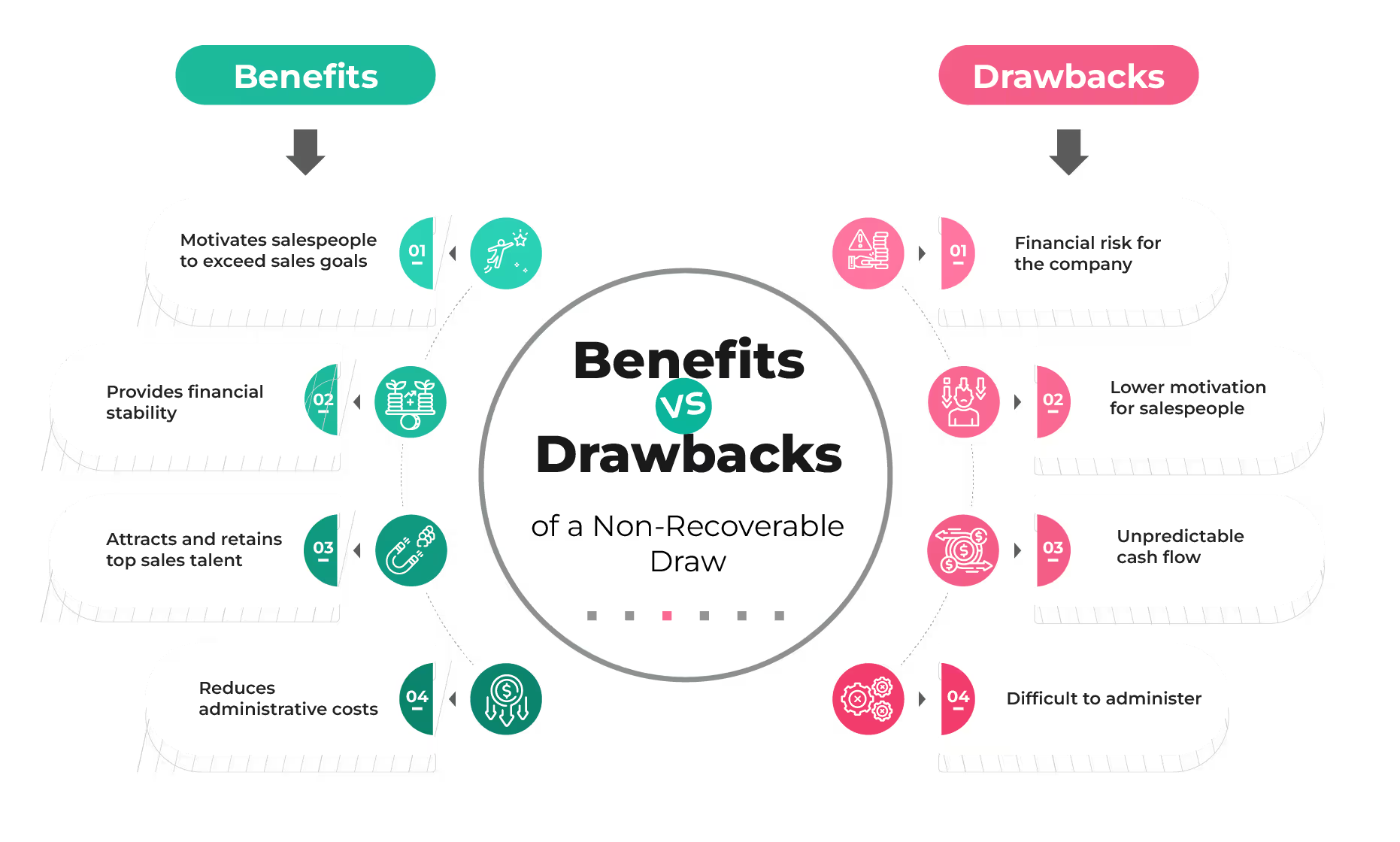
Blog
How to use a Non-Recoverable Draw Against Commission in your Sales Comp Plans
May 30, 2023


Key Insights
Sales compensation plans typically offer a combination of base salary and commission, with the latter incentivizing salespeople to meet or exceed their targets. However, some sales organizations also use a non-recoverable draw against commission to help their sales representatives bridge the gap between their earnings and their sales quotas.
In this blog, we will explain what a non-recoverable draw against commission is and how to use it effectively in your sales comp plans.
What is a Non-Recoverable Draw?
A non-recoverable draw is a form of advance payment given to sales professionals before they earn enough in commissions to cover the draw amount.
Unlike a recoverable draw, which allows the employer to recoup the advanced funds from future commissions earned by the salesperson, a non-recoverable draw does not require repayment, regardless of the individual's sales performance.
Example of a Non-Recoverable Draw
Imagine a sales representative receiving a monthly non-recoverable draw of $2,000. Even if their commission earnings for that month amount to only $1,500, the salesperson would still keep the full $2,000 draw without having to pay back the excess $500.
This can provide financial stability for sales professionals during slower months or when building up a client base.
Why Offer a Non-Recoverable Draw?
How Does a Draw Work in Sales?
Offering draws is a common practice in sales environments to motivate reps and provide them with a predictable income. A draw system ensures that salespeople, irrespective of their role as a sales representative vs sales associate, have a consistent source of income, especially during periods of low sales. Non-recoverable draws, in particular, offer the added benefit of relieving the pressure to repay the advanced funds, allowing sales professionals to focus on their work without the burden of payback expectations.

Recoverable vs. Non-Recoverable Draw
The decision to offer a recoverable or non-recoverable draw often depends on the company's financial policies, the industry's sales cycle, and the level of risk the employer is willing to assume.
Non-recoverable draws are a more straightforward form of financial support for sales teams, providing a safety net without the need for future repayment.
In contrast, recoverable draws are a financial investment by the employer, with the expectation that the salesperson will eventually generate enough commission to cover the advanced funds.
Employers must carefully consider their business model and the nature of their sales processes when determining which draw structure aligns best with their goals.
In conclusion, non-recoverable draws offer sales professionals' financial security without the obligation of repayment, creating a supportive environment that enables them to focus on their sales efforts. This approach can be an attractive option for businesses looking to motivate and retain talented sales teams while minimizing the complexity of financial arrangements.
What is a Non-Recoverable Draw Against Commission?
A non-recoverable draw against commission is a type of advance payment made to sales representatives. It is called "non-recoverable" because the sales rep is not required to pay it back, regardless of whether they meet their sales quota or not.
The draw is typically deducted from the sales rep's future commission payments, effectively acting as a loan against their future earnings.
For instance, suppose a sales representative has an on target earnings with an annual commission target of $100,000. However, they encounter difficulties closing deals during the first quarter. To support them during this period, their employer may provide a non-recoverable draw against commission amounting to $25,000, intended to cover living expenses until they can regain momentum. If the sales rep ends up earning $80,000 in commission for the year, their final payout will be $55,000 after deducting the $25,000 non-recoverable draw.

Benefits of a Non-Recoverable Draw:
The purpose of a non-recoverable draw is to provide salespeople with a stable income stream while incentivizing them to achieve sales goals. Here are some potential benefits:
- Motivates salespeople to exceed sales goals: By providing a guaranteed minimum income, a non-recoverable draw can reduce the financial stress of salespeople and help them focus on achieving their sales targets. The salesperson knows that they must meet or exceed their sales goals to earn commissions above the draw amount, which can motivate them to work harder and close more deals.
- Provides financial stability: Sales can be unpredictable, with some months being more successful than others. A non-recoverable draw provides salespeople with a consistent income stream that they can rely on to pay their bills and support their families.
- Attracts and retains top sales talent: Offering a non-recoverable draw can make your sales job more appealing to potential candidates and help you retain top-performing
salespeople. Knowing that they will have a guaranteed income can give salespeople more confidence to join or remain with a company, even during challenging times.
- Reduces administrative costs: A non-recoverable draw can reduce the administrative burden of calculating and paying commissions. With a fixed draw amount, the sales commission calculation becomes simpler and more predictable, which can reduce the time and effort required to manage sales compensation.
It's important to note that a non-recoverable draw is not suitable for all sales teams or industries. Companies should consider their specific sales environment and consult with sales compensation experts to determine if it is an appropriate compensation structure for their business.

Drawbacks of a Non-Recoverable Draw:
There are several drawbacks to using non-recoverable draws as a sales compensation structure including:
- Financial risk for the company: With a non-recoverable draw structure, the company is taking on the financial risk of paying out a draw, regardless of the sales performance of the salesperson. If the salesperson does not generate enough sales to cover their draw, the company loses money.
- Lower motivation for salespeople: Salespeople may become complacent and less motivated to exceed their sales goals if they know they are receiving a guaranteed draw. They may feel less pressure to generate sales and may not put in as much effort as they would with a purely commission-based structure.
- Unpredictable cash flow: Unpredictable cash flow: Non-recoverable draws can create unpredictable cash flow for the company. If sales are slow, the company may be paying out more in draws than it is bringing in from commissions, impacting the 'forecast vs projection' of financial resources. This can create financial strain on the company, especially if it is a smaller business.
- Difficult to administer: These structures can be difficult to administer. Companies may need to closely monitor sales performance and adjust the draw amount to ensure that it is in line with actual sales performance. This can create additional administrative work and costs.
- Potential legal issues: Non-recoverable draw structures can also raise legal issues. In some states, there are laws governing how much of a salesperson's earnings can be taken back in the event that they do not meet their sales goals. This can create legal issues for companies that are not in compliance with these laws.
While non-recoverable draws can provide some benefits to both salespeople and companies, there are also significant drawbacks that must be carefully considered before implementing this type of sales compensation structure.
Tips for using a non-recoverable draw against commission effectively:
Non-recoverable draws against commission can be a valuable tool for sales organizations to help their reps stay motivated and focused on meeting their targets. However, they must be used strategically to avoid overburdening sales reps with too much debt or incentivizing them to prioritize short-term gains over long-term success.
Here are some tips for using a non-recoverable draw against commission effectively:

- Set realistic sales quotas: Sales quotas should be challenging but achievable. If quotas are set too high, sales reps may be forced to rely heavily on non-recoverable draws against commission to cover their expenses, leading to excessive debt and demotivation.
- Offer non-recoverable draws as a short-term solution: Non-recoverable draws against commission should be used to help sales reps bridge temporary gaps in their earnings, such as during the slow season or when starting a new territory. They should not be used as a long-term solution for underperforming sales reps.
- Communicate clearly: Sales reps should fully understand the terms and conditions of the non-recoverable draw against commission, including how much they will receive, when it will be paid, and how it will be deducted from their future earnings. Clear communication can prevent misunderstandings and disputes.
- Monitor debt levels: Sales organizations should keep track of how much debt their sales reps are accruing through non-recoverable draws against commission. If sales reps are carrying too much debt, it may be time to reevaluate their quotas or provide additional support to help them improve their performance.
- Use non-recoverable draws as part of a larger sales compensation plan: Non-recoverable draws against commission should be one element of a comprehensive sales compensation plan that includes base salary, bonuses, and other incentives. A balanced compensation plan can motivate sales reps to achieve their targets while minimizing the risk of excessive debt. Implementing a robust sales monitoring template can help track the performance and debt levels of sales representatives effectively.
In conclusion, non-recoverable draws against commission can be an effective tool for sales organizations to help their sales reps meet their targets. By setting realistic quotas, communicating clearly, monitoring debt levels, and using non-recoverable draws as part of a comprehensive compensation plan, sales organizations can use this strategy to motivate their sales reps while avoiding the risk of excessive debt.
Are you using non-recoverable draws in your incentive compensation management plans? Consider leveraging a saas commission calculator for real-time insights from Kennect’s ICM solution! Book a demo with us today to learn more!
ReKennect : Stay ahead of the curve!
Subscribe to our bi-weekly newsletter packed with latest trends and insights on incentives.
Thank you! Your submission has been received!
Oops! Something went wrong while submitting the form.
Your data is in safe hands. Check out our Privacy policy for more info















